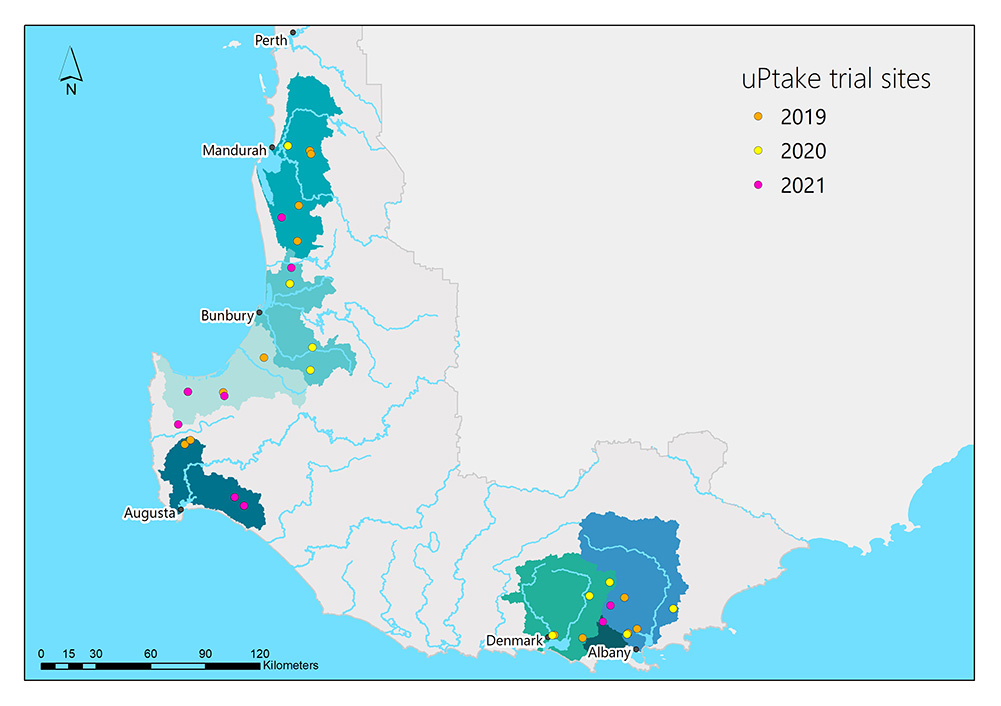uPtake trials
The uPtake project established 52 phosphorus fertiliser trials on grazing properties in six regional estuary catchments (Peel-Harvey, Leschenault, Geographe, Hardy Inlet, Wilson Inlet and Oyster Harbour). Trials were undertaken on a range of soil types with contemporary pasture species.
Results from the trials will be used to refine national data (Better Fertiliser Decisions for Pastures) used for phosphorus recommendations and to build confidence in industry and farmers in the science supporting fertiliser recommendations. The development of the trials, including site selection, trial design and results analysis, has been overseen by the uPtake Technical Reference Group. Members of the Technical Reference Group include research scientists, farmers, and representatives from government departments, catchment groups, grazing industry groups and the fertiliser industry.
The four years of trials from 2019-23 confirmed that the national critical values for phosphorus are relevant to south-west WA and contemporary pasture species. To learn more about the results, download the trials summary.
The work of the uPtake project continues through related projects including Soil Wise and Healthy Estuaries WA.
Selecting trial sites
Trial design
Two types of trials have been established:
- Type A – Fenced for the entire season and plots individually mown every 5–6 weeks to determine biomass (to represent a dairy or intensive beef enterprise).
- Type B – Whole site grazed up until spring, then locked up for biomass measurements (to represent a typical beef hay paddock enterprise).
Treatment 1
0 kg/Ha of phosphorus
Nil basals
2
0 kg/Ha of phosphorus
Basals
3
5 kg/Ha of phosphorus
Basals
4
10 kg/Ha of phosphorus
Basals
5
20 kg/Ha of phosphorus
Basals
6
40 kg/Ha of phosphorus
Basals
7
40 kg/Ha of phosphorus
Nil basals
Basals are nitrogen (60 kg/Ha), potassium (50 kg/Ha), sulphur (24 kg/Ha) and trace elements
Trial results

Trial site locations
2019
Nineteen phosphorus trials were established in 2019 across six regional catchments (map below).
Of the 19 trial sites only five responded to phosphorus application, indicating there was already sufficient phosphorus in the soil in the other 14 sites for maximum pasture growth.
Twelve trials were responsive to the addition of basal nutrients (nitrogen, sulphur, potassium and trace elements) indicating that nutrients, other than phosphorus, were limiting production.
The pasture yield results for all 19 trials were consistent with the national data (within 20 per cent of the predicted response). However, national data predicted a phosphorus response on 11 of the 19 trials where only five were responsive. This suggests that the national data for phosphorus recommendations may be higher than required in south-west Western Australia.
Three sites with low pH and low soil phosphorus were less in line with national data which requires further investigation.
2020
2021
Five new and three continuing trials were established in 2021 through the uPtake project across the greater South West (Peel-Harvey to Oyster Harbour catchments) to examine the response of pastures to phosphorus.
2019 to 2023 results summary
Over the four years 2019-23 we established a total of 52 on-farm trials.
Key learnings from the trial results were that:
- The national critical soil test P values are relevant to south west WA soils and contemporary pasture species
- Adding P to soils with adequate P will not grow more pasture but will increase the risk of P leaching to the environment
- Addressing limiting nutrients like nitrogen, sulphur, potassium & trace elements will increase productivity if nutrients are deficient
- Soil testing is critical to identify nutrients that may be limiting production
- Applying P following national critical values will optimise productivity, profitability and reduce impacts on the environment
Scientific articles
Rogers, D., Weaver, D., Summers, R., Dobbe, E., Master, R., McFerran, R., Mussell, G., Dawson, L., Mercy, J., Richards, P., Holtham, D. (2021) Critical phosphorus values from the Better Fertiliser Decisions for Pastures project: early insights from validation trials. Crop and Pasture Science 72, 731-741.
